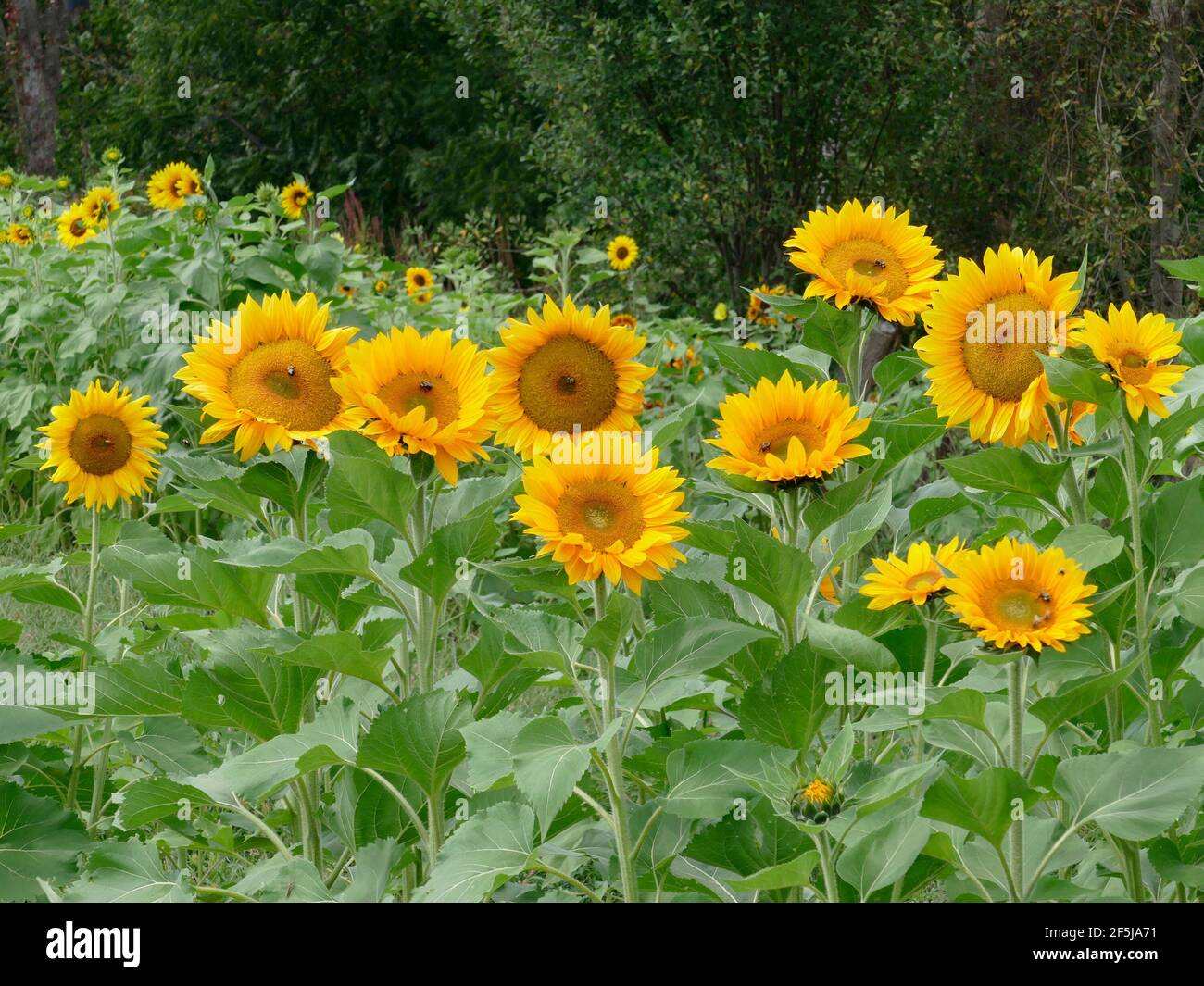There are sunflowers, and then there are SUNFLOWERS! Mammoth sunflowers are the king of sunflowers. If you want to wow your kids, the neighbors, or even the squirrels, these are the sunflowers you should grow.
Mammoth Sunflowers are an heirloom variety that originated in North America. They are prized for their enormous head that can grow up to 14 inches across. Sunflower stalks can get as tall as 12 feet and as wide as a small tree cutting. The thick stems support the weight of the heavy head full of delicious sunflower seeds. Plant Mammoth Sunflower Seeds for a beautiful sunflower that stands tall in your garden and gives you a lot of seeds to eat.
Sunflowers are iconic summer blooms, with their bright yellow petals radiating from a central chocolate-colored disk. But occasionally, you may stumble upon an oddity – a mammoth sunflower sporting not just one, but a multitude of smaller heads budding off the stem. What causes this mutation, and should you be concerned? Let’s dig into the science behind mammoth sunflower blooming gone rogue.
Typical Traits of Mammoth Sunflowers
First, to understand the abnormal, we must explore the normal. Mammoth sunflower varieties are bred to be, well, mammoth. They can tower over other sunflowers at heights over 12 feet, with massive seed heads spanning 1 foot or more in diameter.
The genetics behind most mammoth sunflowers like Mammoth Gray Stripe produce a single large terminal flower on each plant.LOWERCASE But nature sometimes has other plans. Cross-pollination can introduce unexpected traits, and mammoths occasionally manifest multiple smaller heads sprouting from leaf axils down the stem.
Causes of Multiple Heads
This fasciation mutation likely arises from cross-breeding If mammoth plants are grown near smaller multi-headed sunflowers like the variety Valentine, visiting pollinators may transfer some mutant genes. The resulting seedlings express both parents’ traits
While not ideal for mammoth breeders seeking that perfect solitary mega-bloom, these multi-headed mammoths aren’t detrimental. They simply divert energy into several smaller flowers rather than one enormous one. If desiring a single bloom, pruning off the auxiliary buds may help the plant focus resources.
Stability of the Mutation
Will those odd auxiliary heads persist if planting the seeds? Possibly, but mutations often revert and stabilize over generations.
One gardener reported a multi-headed sunflower that produced 5th generation seeds still exhibiting proliferation. However, the number of heads slowly declined each generation, suggesting a gradual return to the expected single mammoth head.
No Cause for Concern
So what happens if your mammoth sunflowers start sprouting extra blooms? No need to worry. This mutation doesn’t harm the plant although it may reduce the size of the main flower. The cause is likely cross-pollination and introgression of a proliferating sunflower variety in recent ancestry.
While stability varies, in most cases the mutation will fade over generations if seeds from the largest main heads are replanted Otherwise, embrace the diversity and enjoy the bonus flowers The bees certainly won’t complain!
Enjoying Multi-Headed Sunflower Varieties
For those enchanted by sunflowers’ golden crowns, occasionally discovering a mammoth plant flaunting frilly rows of duplicate blooms can be a delightful surprise. But why leave such delights to chance? Some sunflower varieties are actually bred to be multi-headed! Consider giving these varieties a try:
-
Sundance Kid – This dwarf sunflower reaches just 2-3 feet tall but has a prolifically branched habit supporting multiple 4-6 inch blooms.
-
Florenza – With heights around 3 feet, each plant bears 5-15 medium 4-6 inch flower heads.
-
Soraya – A mid-sized sunflower topping off around 5 feet tall and lined with clusters of 3 inch yellow petaled flowers with dark centers.
-
Paula – A double-flowered variant producing rows of small yellow-orange pompom like spheres along each branch.
The Allure of Anomalies
Seeing mammoth sunflowers flaunting tiny offshoot flowers reminds us of nature’s endless creativity. While mutations can be unpredictable, they provide valuable diversity. Occasional crosses between plant varieties generate new possibilities which may become beautiful new cultivars.
So if your mammoth sunflower starts sprouting a few extra blooms, appreciate them for adding charm and whimsy to your garden. The flowers will still be lovely, and you’ll have an intriguing story behind their unusual growth. Sometimes anomalies are not mistakes, but happy accidents bringing more beauty into the world.
How to Plant Mammoth Sunflower Seeds
Sunflowers are one of the easiest flowers to grow. And the same holds true for Mammoth Sunflowers. But because they are so big, there are some things you should know to get a great harvest of sunflower seeds.
Sow Right Seeds – Mammoth sunflowers growing next to the barn.
Sowing Mammoth sunflower seeds outdoors
Mammoth sunflower seeds are simple to sow directly into the ground outdoors.
Plant seeds 1” deep. Sunflower seeds don’t need light to germinate; this depth will keep them away from birds.
Put netting over the seeds until they are sprouted to keep birds and other animals from eating them.
Plant 2 to 3 seeds per spot in case one gets eaten. Once they have sprouted, thin out to keep the strongest plant.
- Once there is no longer any risk of frost, plant seeds an inch deep.
- Keep soil moist but not soggy.
- Sunflower seeds germinate in 7 to 14 days.
- Mature sunflower plants prefer drier conditions.
How to Grow Sunflowers Successfully At Home
- The Ultimate Guide to Growing Strawberries in Raised Beds - August 8, 2025
- No-Dig Garden Beds: The Easiest Way to Grow a Beautiful Garden - August 6, 2025
- How to Protect and Preserve Wood for Raised Garden Beds - August 6, 2025

